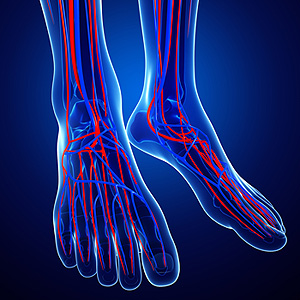Manalapan
(732) 845-0100
Manalapan (732) 845-0100
 Peripheral artery disease, commonly referred to as PAD is the result of a blockage due to lack of blood flow in the lower extremities. Symptoms of this ailment generally consist of slow healing foot wounds, consistent leg pain, or a lower temperature that is present in one foot when compared to the other foot. This condition is typically noticed when the muscles are exerted during an exercise program. At this time, these working muscles need additional blood flow, and if afflicted, completion of proper exercises may be challenging. Research has shown the importance of obtaining a proper diagnosis which may include undergoing certain tests that are specific to this condition. Please schedule a consultation with a podiatrist if you would like additional information about PAD.
Peripheral artery disease, commonly referred to as PAD is the result of a blockage due to lack of blood flow in the lower extremities. Symptoms of this ailment generally consist of slow healing foot wounds, consistent leg pain, or a lower temperature that is present in one foot when compared to the other foot. This condition is typically noticed when the muscles are exerted during an exercise program. At this time, these working muscles need additional blood flow, and if afflicted, completion of proper exercises may be challenging. Research has shown the importance of obtaining a proper diagnosis which may include undergoing certain tests that are specific to this condition. Please schedule a consultation with a podiatrist if you would like additional information about PAD.
Peripheral artery disease can pose a serious risk to your health. It can increase the risk of stroke and heart attack. If you have symptoms of peripheral artery disease, consult with Dr. Charles Marchese from Manalapan Foot & Ankle. Our doctor will assess your condition and provide you with quality foot and ankle treatment.
Peripheral artery disease (PAD) is when arteries are constricted due to plaque (fatty deposits) build-up. This results in less blood flow to the legs and other extremities. The main cause of PAD is atherosclerosis, in which plaque builds up in the arteries.
Symptoms
Symptoms of PAD include:
It is important to note that a majority of individuals never show any symptoms of PAD.
Diagnosis
While PAD occurs in the legs and arteries, Podiatrists can diagnose PAD. Podiatrists utilize a test called an ankle-brachial index (ABI). An ABI test compares blood pressure in your arm to you ankle to see if any abnormality occurs. Ultrasound and imaging devices may also be used.
Treatment
Fortunately, lifestyle changes such as maintaining a healthy diet, exercising, managing cholesterol and blood sugar levels, and quitting smoking, can all treat PAD. Medications that prevent clots from occurring can be prescribed. Finally, in some cases, surgery may be recommended.
If you have any questions, please feel free to contact our offices located in Manalapan, NJ, and Staten Island, NY . We offer the newest diagnostic and treatment technologies for all your foot care needs.
Read more about Peripheral Artery Disease